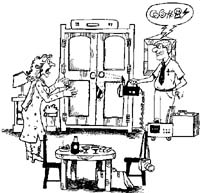You can run...
 gene Greneker has invented an easy way to spot each and every would-be assassin, thief, plain prankster or perhaps, an earthquake victim behind a wall or a closed door. This crafty little trick has been done through a gadget that the inventor calls a radar flashlight. Greneker, a researcher with the us-based company Georgia Tech, has developed the flashlight, a device that detects the slight rise and fall of a person's breathing chest, and is sensitive enough to spot someone standing as much as six feet behind a solid concrete wall.
gene Greneker has invented an easy way to spot each and every would-be assassin, thief, plain prankster or perhaps, an earthquake victim behind a wall or a closed door. This crafty little trick has been done through a gadget that the inventor calls a radar flashlight. Greneker, a researcher with the us-based company Georgia Tech, has developed the flashlight, a device that detects the slight rise and fall of a person's breathing chest, and is sensitive enough to spot someone standing as much as six feet behind a solid concrete wall.
A transmitter at the head of the flashlight sends out a low-energy microwave signal that can penetrate doors or walls (unless these are made of metal, which reflects most of the signal). When the beam strikes something on the other side of the wall, it bounces back to the receiver, also located in the head of Greneker's "flashlight".If the target object moves, the return frequency shifts slightly from the original signal - shortened if the target moves towards the detector, lengthened if away form it.
In laboratory tests, Greneker determined the types of frequency shifts that would be likely to be caused by a human torso during normal respiration. Then he built a signal-processing system that could extract just those frequencies - preventing, for instance, the breathing of a rat form the triggering device. The system is wired to the flashlight, as is the computer screen that displays the signal. "You see them as they breathe. It's like the ecg machine, where you have a flat line, followed by a little hump, then another hump," he explains.
Greneker's device could prove to be a lifesaving invention. Rescue workers could use it to locate accident victims trapped in the rubble of collapsed buildings, and it would be a boon to police officers searching for hidden suspects. "If I had to go into an unknown home at night and do a search of the closets," says Greneker, "I sure would like to have something to look through that door before I opened it to find an armed man on the other side ready to shoot me."
However, before this nifty device can be released commercially, the researchers have to miniaturise the radar device, signal processor and the power supply and incorporate these into a single, portable unit. A concealed person's respiration signature could appear as a flashing light or a tone rather than a blip on a bulky computer monitor. "The police might not want the detector to make any sounds," Greneker says, "you might put in a little buzzer that vibrates, or a bar that oscillates, like the one on your stereo system that tells you the volume. It might be something just as simple as that."
Related Content
- Status report of Punjab Pollution Control Board regarding pollution of Buddha nallah, Ludhiana, Punjab, 22/04/2024
- Order of the National Green Tribunal regarding disposal of fly ash by the thermal power station run by NTPC, Kanti, Muzaffarpur, Bihar, 12/04/2024
- Order of the National Green Tribunal regarding running of five hadda roddis (dump yard for dead animals) in the close vicinity of river Sutlej, Ludhiana, Punjab, 05/04/2024
- Order of the National Green Tribunal regarding extension of registration period of specialized armoured vehicles, 22/03/2024
- Amendment in the final notification of eco-sensitive zone around Sukhna wildlife sanctuary in the state of Haryana
- Order of the National Green Tribunal regarding illegal stone crushing and mining units in Rewa district, Madhya Pradesh, 28/02/2024
